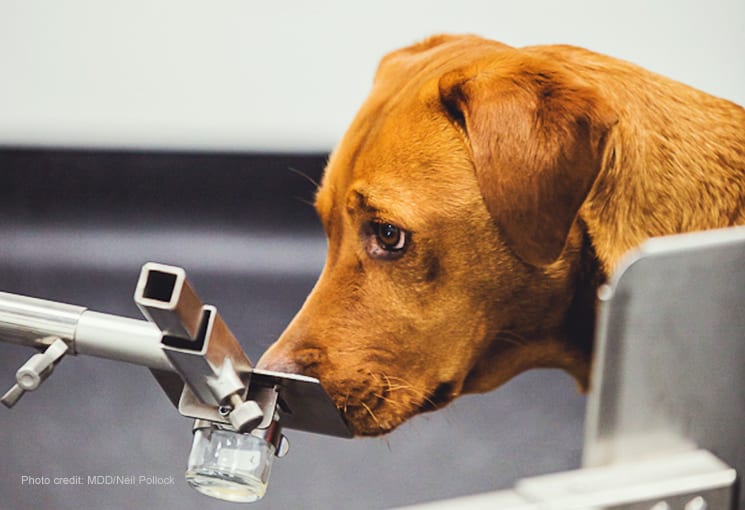Dogs with an excellent sense of smell can detect molecules in parts per trillion. Trillion! Hunting dogs, like Retrievers and Spaniels, and some working dog breeds, like German Shepherds (and mixes thereof) have 300 to 350 million sensory receptors; in comparison, humans have maybe 5 million. Although the human brain is larger than a dog’s brain, the part of the brain that controls smell is 40 million times greater in dogs!
So it makes sense that dogs can detect cancer – but this was only proven fairly recently. “Using dogs’ sense of smell in medical detection started anecdotally,” says Claire Guest, psychologist, registered pet behaviorist, co-founder and Chief Scientific Officer of Medical Detection Dogs, the UK-based group that is leading the revolution in cancer detection.
Guest was a co-author on the first major scientific article, published in 2004 in the British Medical Journal, showing that dogs could smell bladder cancer in a small drop of urine. “I was first introduced to this idea by a colleague who had a pet Dalmatian.” The dog kept sniffing at a mole on the friend’s calf. “It was really irritating; she kept pushing the dog off, but she eventually went to her GP, who removed the mole, and told her it was malignant melanoma. From that time on, I knew this dog had smelt it.” Guest set out to prove that cancer has a unique smell, and that dogs can find it.

Medical Detection Dog
These cancer-sniffing canines are so good at what they do that it could lead to a revolution in prostate cancer detection.
But duplicating this electronically – work PCF is funding, with the hope of detecting aggressive prostate cancer early – using sensors that can detect “volatile organic compounds” (basically, molecules of odor) is not so easy. Guest explains why: “Prostate cancer is not going to turn out to be a single note. What dogs are really good at discovering is a tune. Think of Beethoven’s Fifth Symphony, those first few notes. We suspect the cancer signature is something like that. It’s a pattern; the dogs are really good at recognizing the pattern. Machines that recognize the notes but can’t read the pattern are not reliable biomarkers.”
So her next task is, somehow, to teach the dogs to translate the pattern they’re smelling. “If I were trying to teach you what lavender smells like, you would say, okay, this is a really good example, and here’s a really bad example that has no smell. You start to learn what distinguishes lavender.
“The dogs are teaching us right now,” Guest continues: every day is a tutorial on how to interpret the information “that your body is constantly giving off. They’re not so much workers as teachers.”
What Exactly Are the Dogs Smelling? It Could Be Bacteria
PCF-funded scientist Karen Sfanos, M.S., Ph.D., of Johns Hopkins, discovered several years ago that a basic medical assumption was just plain wrong: “We had always been told that urine was sterile,” she says. “It’s not.” Her research revealed that urine has its own microbiome – its own population of bacteria.
Jonathan Simons, M.D., former CEO of PCF and now Board Member, recently approached Sfanos with a question: “Could what the dogs are smelling be related to microbes in the urinary tract?” Sfanos was the ideal person to ask: she has access to an extensive biorepository at Hopkins, with thousands of urine samples that are linked to prostate pathology specimens. And in early research, she has found that men with aggressive prostate cancer – Gleason grade 9 – have different microbes in their urine than men with lower-grade cancer. “There’s certainly much more work to be done,” and larger studies are needed, Sfanos says.
That said, she adds: “I think it’s been wholly underappreciated, the level of involvement that microbes have in everything that goes on with our bodies.”
So: Could high-grade cancer be associated with its own particular population of bacteria, and could it be these bacteria that make the distinctive smell that the dogs can detect? This remains to be seen, but it’s quite possible.
Previous – Part 1: Meet the Dogs Leading the Revolution in Prostate Cancer Detection










